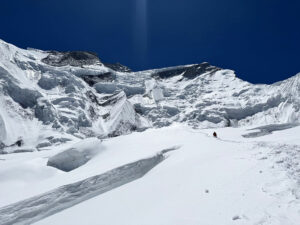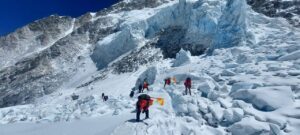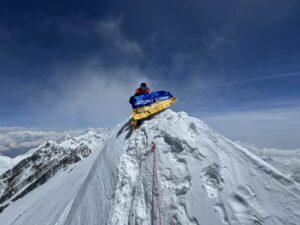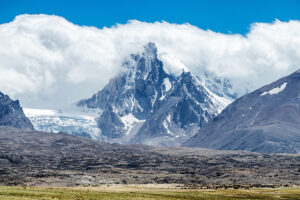A Czech team attempting unclimbed Muchu Chhish has drawn attention toward the obscure peak, located in remote Batura Muztag.
As we noted previously, Muchu Chhish’s altitude ranks it as the highest unclimbed peak in Pakistan and the second in the world after Bhutan’s Gangkhar Puensum, which is banned for climbing because of religious reasons.
However, as mountaineering and polar historian Damien Gildea told ExplorersWeb, if we consider Muchu Chhish in terms of prominence, it can barely be called a mountain. Muchu Chhish has just 263m of prominence.
“It’s really just a sub-peak of the Batura chain,” Gildea says. “Gangkhar Puensum, on the other hand, is a real mountain, with 2,995m of prominence.”

Muchu Chhish’s location on the Batura Muztag ridge.
What is prominence?
Prominence measures “how high a mountain rises above its immediate surroundings,” as Dave Philips writes in Out There Colorado. It is the drop from a summit to the lowest point between it and the next mountain, which is known as the key saddle.
The concept of prominence became noteworthy when climbers started going up mountains for sport and, especially, collecting mountains. Prominence is crucial to these lists, from the 14,000’ers (in feet) in the United States to the European Alps’ 4,000’ers to the Himalayan 8,000’ers. It helps differentiate the main summit from a subsidiary peak or a secondary summit.
It also helps assess chain-climbing several peaks in a certain amount of time.
What is not clear is the exact prominence needed to be a mountain. The UIAA requires a 30m drop, plus some mountaineering and morphological characteristics, to include a mountain in the Alps as an autonomous 4,000m peak. Peakbagger.com’s list of U.S. 14,000’ers shows 300 feet of clear prominence.
Prominence vs dominance
In the Andes, 6,000m peaks are classified according to a slightly different concept: dominance. This consists of the percentage between the prominence and the total height of the mountain. It must be over 7% for the main peak, between 2.10% and 6.99% for a subsidiary peak, and between 0.7% and 2.99% for a secondary summit, according to Estilo Alpino.

Aconcagua, Argentina ranks second after Everest in terms of prominence. Photo: Miviaje.com
Prominence and dominance are remarkable in American mountains. After Everest, Aconcagua is the second most prominent peak in the world (at 6,960m of prominence), followed by Denali (6,144m).
Eberhard Jurgalski of 8,000ers.com has a comprehensive article on dominance. In the case of Muchu Chhish, by the way, its dominance is only 3.5%.
Prominence provides new challenges for peak baggers. They can now focus on the peaks that are the most prominent rather than the highest peaks in an area. For those looking for ideas, Aaron Maizlish’s Peak List is an ambitious project trying to list all the mountains in the world with over 1,500m of prominence.
While the debate around altitude vs prominence is open, it shows the limits — but also the possibilities — of peaks that are actually points on a massif. The challenges on Muchu Chhish begin, for example, on the sharp rib between Camp 2 and Camp 3, and on the long ridge well before the summit. Likewise, it opens the options for potential traverses of some or all of the Batura massif.

The Czech team’s BC at the foot of Marble peak.
Meanwhile, near Muchu Chhish
As for the Czech team, the three climbers and their local Base Camp staff are currently acclimatizing on Sang-E-Marmar (Marble Peak). The team established Base Camp at 4,200m and has now set up Camp 2 at 5,400m.
“We hope to reach 6,000m today to boost our red blood cells,” they said. They didn’t say whether they planned to reach the summit of Marble Peak. “It started snowing a lot so the weather forecast [was wrong],” the climbers noted.
Wherever they reach, their plan is to move Base Camp to Muchu Chhish around July 11.






